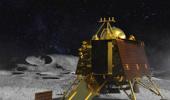'We started AgniKul to show that space transportation should be as simple as road transportation.'

On the 30th of May 2024 when the Mission 01 of Agnibaan SOrTeD (suborbital technological demonstrator) rocket successfully took off to space from their private launch pad at Sriharikota, AgniKul Cosmos, a space start-up based in Chennai became the world's first company to launch a single-piece 3D-printed semi-cryogenic engine.
Srinath Ravichandran, who co-founded AgniKul Cosmos along with Moin SPM, speaks about their journey that started on the 1st of December 2017 and culminated in the first successful test launch of Agnibaan.
"I realised if I had to chase my dream, it had to be in India," Srinath Ravichandran tells Rediff.com's Shobha Warrier.

Was it always your dream to be a space entrepreneur?
I grew up a space enthusiast and it was always my dream to work in an area that is connected with space.
I think it was probably because the dinner conversations in my family were about space.
Soon, I became so passionate about space that even when I was 9 or 10 itself, my reading was mainly on space science.
Did any space scientist in particular, inspire you?
Dr Abdul Kalam was a big inspiration. When I was studying at the Guindy Engineering College, he was the vice chancellor of Anna University.
At that time Anna University had made the first student satellite of India called AnuSat and I had a small part in the team.
I can never forget what Dr Kalam said when he addressed the team one day -- that we will push ourselves towards our dream only when we dream about those things that are out of our reach. That was the first time someone told us that it was okay to dream about something that was unreachable.
It was so inspirational that I felt it was fine to dream about things that looked impossible to achieve!
What was your dream then?
At that time, my dream was to build spacecraft or rockets.
But I never thought about becoming an entrepreneur. I only wanted to be a part of space missions. I wanted to be a part of anything connected with space technology.
Finally, I became an entrepreneur and became part of space missions!
I did my degree in electrical engineering and not in aerospace engineering. That was because everybody in my family dissuaded me from studying aerospace as they said I would find it hard to get a job.
Soon, I switched over to finance and got admission at Columbia university as finance looked the most attractive at that age.
The moment I started working, I realised it was not where my heart was. I was not happy.
I started thinking of the ways to move closer to aerospace as I had already moved many step away.
Soon I realised that unless I studied aerospace, nobody was going to accept me to work in the field.
I quit my job and decided to do another Masters, this time in aerospace engineering.
I moved to Los Angeles as all the space activities were happening there because of Space X. And I attended every Space X conference or meeting happening there.
The problem was if I wanted to meet space scientists, I could only meet them in coffee shops.
After a while I realised if I wanted to do something in space, the USA was not the place.
Is that why you decided to come back?
Yes. Despite what the US was doing in the field of space, there was a marked respect for what ISRO was doing in India.
I wanted to be where the action was and not in coffee shops!
I realised, if I had to chase my dream, it had to be in India.
But the private space sector in India was almost non-existent then. They were only working as suppliers of ISRO.
I was already 31. I knew if I wanted to work in the space sector, I had to be on my own and not work for somebody else.
I also heard that though the satellites were getting smaller and smaller, the rockets were still big.
I wondered why people were not building small rockets.
Was that the Eureka moment?
The Eureka moment was different. In one of our coffee shop meet-ups, one person who is our customer today came with a stroller and took out a full satellite from it.
He wanted to know why he was not able to launch his satellite into space as no space company in the US was willing to launch it for him. But he was able to carry it in his suitcase.
I thought how could it be so difficult?

Was it because it was a small satellite?
Yes, because it was a small satellite. Because it was not aligned with the rockets that were plying. Because the rockets were not aligned with the orbit where he wanted to place it.
The reasons were logistical. It was like there was no transportation to go to the part of the space where his satellite wanted to go.
That was the Eureka moment for me!
It made me realise that there was a problem with rockets and that was when I decided that my work would be in rockets.
I thought if we were to build small rockets, we could solve such problems to some extent.
My market survey found that satellites were becoming smaller, but rockets were still stuck in the past.
What I did next was reaching out to professors across the country who were working with ISRO and had their own labs. I did this even when I was in LA.
My questions to them were, can we build small rockets? Can we collaborate? Can I use your lab?
Only one professor, Professor Satyanarayanan R Chakravarthy from IIT Madras told me, let's try it out.
The moment I read his reply, I quit my job in the US and came back to India.
I then reconnected with my friend Moin. Other than the two of us, there was Professor Chakravarthy.
Later a couple of interns from IIT Madras joined us.
That was how I ended up becoming an entrepreneur.
What were the challenges you faced as an entrepreneur in the initial days?
When Moin and I met people and explained to them that we were building rockets, so many of them thought we were crazy. What we said was not taken seriously. In fact, so many of them advised us on what we should be doing.
Since ours was the first company in the rocket space in 2017, it was very challenging to make people take us seriously. Even Skyroot was incorporated only in 2018.
So, it needed a lot of effort to convince people that what we were going to do is serious business.
On the 1st of December 2017, we officially registered our venture, AgniKul Cosmos.
What is significance of the name AgniKul?
I believe we have to be lifelong learners.
I wanted the name of our company should reflect learning which can take us to the next frontier. The early days of learning were the Gurukulams.
In an orbit engine, the first thing you develop is how to deal with fire, agni.
So, our company should be a gurukul for agni or the way to use agni.
Above all, the most fundamental aspect of human civilisation is fire.
Getting into space is a new frontier for everyone and the first thing to do that properly is to learn to use fire.
That's why I decided on the name, AgniKul!
How did you manage the initial funding?
The initial funding of Rs 60 lakhs (Rs 6 million) was put in by Moin and I, savings from our job.
The biggest challenge we faced was to convince people that it was not our hobby, and we were building something important. So, to make people to believe and invest in us, we have to show investors something.
We did our first testing in September 2018. Today, we have 3D printed engines, but what we did in 2018 was a conventionally made small engine following the traditional method.
We got our first investor after that. We raised half a million dollars from Speciale Invest.
With the funding, we got recognised among the venture capital community.

What was the road map you had planned for the rocket, which was first a conventionally made small engine?
First, from the small rocket, we would move to a larger one with new technology like 3D printing.
Then, we had to get approval from ISRO for the rocket launch.
We also started working on the electronics and software involved in rocket building.
At that time, rockets were looked upon as a hardware product where software took a second step.
When you look at any new product in the global market today, hardware is secondary, and software rules.
We thought why couldn't rockets also be that way? Why couldn't we have a software centric approach while building the rockets? Let the hardware be the enabler.
Our approach was to come up with the best way to build a rocket with the software and electronics approach.
Writing the software took a lot of effort, and 2020 and 2021 went in this.
This is where the next big positive coincidence happened.
When the Government of India came out with the Atmanirbhar Initiative, ISRO decided to include the private sector too in its missions. That changed the entire scenario.
Soon after listening to the news on TV, I wrote a mail to the ISRO chairman, K Sivan, listing what we planned to do.
Interestingly, I got a reply back from him.
The moment ISRO opened its doors to us, many other positive things also happened, like the next set of funding.
I must say ISRO has been extremely supportive of our initiative.

Why did you decide to establish your office and factory at the IIT Research Park?
One, it was next to IIT Madras.
We worked using the students' working space at IIT Madras. But we could move to our proper office at the IIT Research Park only by the end of 2021, after the pandemic.
We then established a full floor as our factory at the IIT Research Park itself. That is where we build our engines etc.
Imagine, having a manufacturing facility where we use all heavy machinery on the first floor!
But our goal was to make the vehicle transportable and mobile.
The advantage of being at the IIT Research Park is the ecosystem it provides, and the footfall of many interesting people associated with software, electronics and space.
Instead of being a small start-up in some corner of Chennai, we were in the middle of all activity.
It was a very conscious decision.
2022 was a big year for us.
First, we set up the factory at the IIT Research Park.
Second, we got ISRO's approval to set up our own private launch pad at Sriharikota.
Third, we got permission to test our engines at Sriharikota which we were till then testing at the facility at IIT Madras.
By then, our team has grown to 250 people.
In September 2023 we took our rocket, Agnibaan to the launch pad at Sriharikota.
We had a successful launch in May 2024.

How do you describe those moments when the countdown for the launch started?
That was a very new experience for all of us.
Though we had gained experience in manufacturing and testing, we didn't anticipate the kind of complexity of the launch.
20 teams from our Chennai office came to Srikarikota to work on the launch. To bring our team to the level at which ISRO works for launches was very difficult. To have the same level of discipline and planning which ISRO has, was very challenging for us.
The weather in May in Sriharikota was very hot and harsh and we were working from 4 pm to 10 am in the morning!
Though our own launchpad was at the ISRO complex, it was 25 to 30 km from the ISRO launchpad.
It is such a huge place that the direction people would give is like this, 'Go 5km straight and then another 10 km to the right...!
We had to call off three of our launches because we were not ready even though the dates were announced. Then, there was another setback too.
The May 30th launch, in fact was our fifth attempt. By then, the entire team had become almost detached.
We were so close but every time, we faced a new problem. So, it was a proper learning process for the entire team.
At midnight on of May 30th, the countdown started; our third countdown.
When the vehicle took off without any problem, there was no time for us to process what exactly happened.
It was like we were looking at the data on the screen, and suddenly the rocket was off.
Finally, when we realised the launch was a success, almost everyone at ISRO Mission Control and AgniKul Mission Control broke down. It was a very emotional moment.
When we saw the ISRO scientists who have seen so many launches getting excited at what we were doing, it gave us a lot of pleasure and satisfaction.

How important was the team's contribution for the launch?
Everything. It was only teamwork that made the launch a success.
It is not possible to do this by one or two persons. It was almost 200 people coming together for this project. We had 20 teams in Chennai and 20 teams at Sriharikota working on this.
Every single person has his or her signature on the vehicle. And in the process, the vehicle also has its signature on you.

How did you celebrate after the successful launch?
Most of the people were young, and what they wanted was sleep!
We had hardly 2-3 hours of sleep for the last one month, and it was not just physically but emotionally also draining for everyone.
In fact, we gave a couple of weeks off for the core team.
But like ISRO says, the celebration is thinking about the next big mission!
By the time the team came back after the break, the data had come and they have started analysing it.
It was like, you have done all the screaming and yelling, and slept too. Now, it is back to Mission 2.
What is the next mission?
Our next mission is to take the rocket to the orbit. What we did was a sub-orbital mission. What we did on the 30th of May was only a test mission.
In fact, we have been working on the orbital mission for some time.
Though we have not scheduled it, it will be in the middle of next year.
How has the response been from the rest of the world?
We have been getting a lot of enquiries from Europe and Australia.
Similarly, the investor community across the world also has shown interest.
This launch was to show all of them that we know how to build rockets.
Till the launch, there was some apprehension about the technology we were following.
Your dreams for the future?
We started AgniKul to show that space transportation should be as simple as road transportation.
Our goal is to make space more accessible. It is like building a new highway to a city. When there is more connectivity to space, more experiments will happen in space.
Space transportation has to be like booking a cab.
Feature Presentation: Ashish Narsale/Rediff.com











